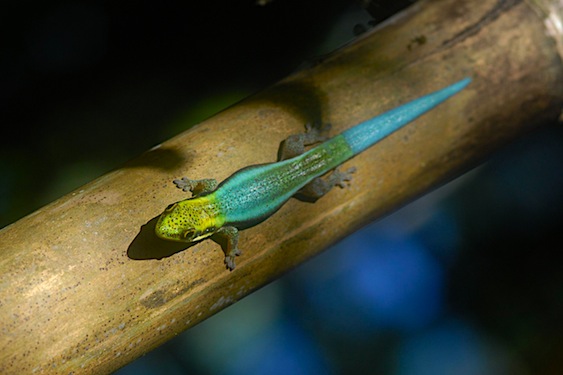
Image © Emmanuel Van Heygen
Description
The most conspicuous of all species is without doubt Phelsuma klemmeri. The dorsal coloration is brown to turquoise with turquoise dorsilateral bands. A black lateral line runs from the eyes towards the hind legs and is interrupted at the ear openings. Before and after the ear P. klemmeri has one or more larger turquoise tubercle scales. This unique feature is only found this explicit in two other species of the genus; P. nigistriata, a bamboo dwelling endemic to Mayotte and P. pronki, a recently discovered arboreal species of central Madagascar. The head and neck are yellow, the ventral coloration is whitish while the region of the femoral pores is yellow in males. P. klemmeri has a very flat appearance and the scales are extremely small and smooth.
Distribution
P. klemmeri is so far only known from the type locality, indicated by Seipp (1991) as the coast of northern Madagascar and the Ampasindava peninsula. The species is widespread on the Ampasinadava peninsula and is not as endangered as previously suggested due to the fact that its habitat is actually extended by human action. Before their habitat was confined in fragmented bamboo “islands” within the primary forest, but the destructive slash-and-burn technique of the Malagasy farmers gave at least these species new opportunities because new bamboo forests arose in previously cleared areas.
Terra Typica
North-western Madagascar
Localities
Ambalihabe, Ambaliha, Ankify, Bezavona
Biotope
This gecko could only be found on medium sized bamboo. When disturbed they immediately retrieve in their hiding, usually one of the many cracks in older dead bamboo which they easily can access due to their flattened bodies. This species is very well adapted to bamboo. Eggs are deposited in these cracks as well. They avoid the hotter parts of the day and can only be seen in the early mornings, in late afternoon or right after a shower when the sun comes through again.
